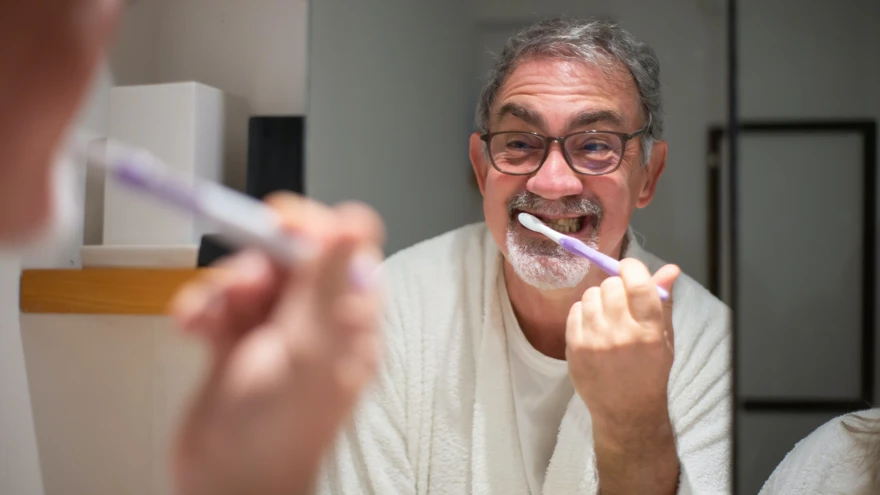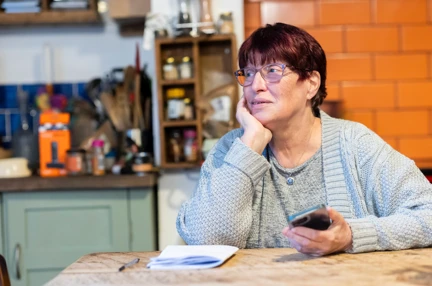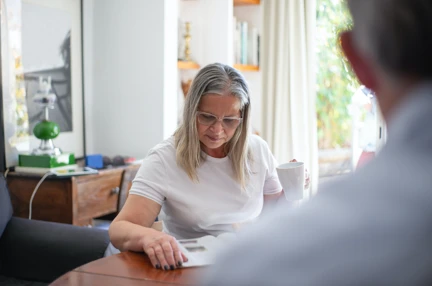Getting ready for the day with low vision
Sight loss can complicate all aspects of daily life, even your morning routine.
However, with a few simple tweaks – and a bit of practise – getting yourself washed, dressed and ready for the day can become much easier.
The following techniques are commonly used by our veterans...

Keeping yourself clean
Create a routine for your personal hygiene if you don’t have one already, as you can no longer rely on seeing what’s needed when.
Keep your toiletries somewhere safe and easy to find. It may help to put an elastic band around, say, the shampoo bottle to help you identify it, or use large stickers to help differentiate between items.
Think of the shape and colour of toiletries when you buy them. Contrast is king, so go for items that will stand out.
When brushing your teeth, put the toothpaste straight into your mouth, rather than trying to get it on the brush.
Gentleman, we have to say it, it can be easier (and more hygienic) to sit rather than stand when using the toilet to avoid spillages.
Many bathroom cleaning products, especially bleach, have braille on them. Even if you can’t read it, it may help you identify it.
"Having a routine is key to personal hygiene and making sure that all bases are covered when it comes to cleanliness."
Looking after your appearance
Consider extra lighting in the bathroom – these days, it’s possible to buy good, illuminated mirrors and waterproof lights, though be careful of creating glare on reflective surfaces.
For shaving, it’s far easier to go electric or, if you do prefer a wet shave, get a good quality razor and shaving gel.
It’s best to keep all your makeup together so you can find what you need, and create a system for applying it. It might be worth practising with a friend to help you get the feel of too much or too little.
It can be useful to keep everything you need for your grooming routine on a tray and, if possible, keep it in a captive space where things can’t roll away.
"If you have a little sight then the right lighting, along with a strong magnification mirror, can make a huge difference."
Getting dressed
Keeping pairs together
Join your pairs of socks together with ‘sock locks’, which you can buy to keep them together through the wash. Clothes pegs will also do the job.
Better still, make your life easier by buying socks all the same colour.
Clothes pegs or matching stickers added to the insoles of a pair of shoes will help make sure you avoid leaving the house with odd shoes on.
Identifying clothing
Braille clothing identifiers and textured labels on clothing tags can help you differentiate between similar clothes and show you which way round they should be worn.
You can also cut the label in your clothes to differentiate them. For example, a corner off means it’s red; a slice in from one side shows it’s green etc.
Different types of hangers, or adding something to a hanger such as beads, is a good technique for finding specific clothes.
Putting clothing the right way round on the hanger can help save you time when it comes to getting dressed, while organising clothes by colour can also be helpful.
"There's a range of apps that can help you with storing, matching and identifying clothes, including virtual assistant apps. Have a look at the RNIB website to find out more about these."
Taking your morning meds
If you take eye drops, it can be easier to lie down to pop them in, so you don’t need to tip your head back.
When popping tablets out from blister packs, keep a bowl underneath to catch any tablets that fall.
Do tasks in order. For example, don’t put your watch on until you’ve taken your morning tablets. This will serve as a helpful reminder and provide reassurance.
"Ask your doctor or pharmacist if your prescription tablets can be put in a blister pack and split into your daily doses, so they're easier to take."
Read more sight loss resources
Navigating public transport with sight loss
9 Nov 2023
Practical information to help people with low vision travel with confidence on buses and trains.

How different eye conditions can affect your sight
21 Aug 2023
Understanding the different parts of the eye and how they can affect your vision.

Accessing bills and statements
27 Sept 2023
Accessing the information you need to remain financially independent.
